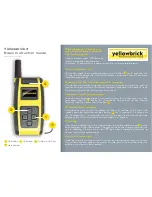
5-8
hsb
2
PLUS Series LCD Display
Wo
rk
in
g w
ith
W
ay
poi
nt
s
5.3 Working with Waypoints
Introduction
The
hsb
2
series Chartplotter enables you to place up to 998 waypoints (in
addition, waypoint number 999 is used for MOB operation): a waypoint is a
position entered on a chart as a reference, or as a place to go to. All waypoints
placed on the chartplotter
are stored in a waypoint database list which
includes symbol, position, bearing, range and additional data. All waypoints
in the database are displayed on the screen, unless you set waypoint display off
in the Chart Set Up menu, as described in
Chapter 7
. You can select a
waypoint, either on-screen or from the list, for editing.
A waypoint can be placed at the cursor position, or at the vessel’s current
position (this is sometimes known as an event mark); a waypoint at the vessel
position includes additional information (if available) on the depth and
temperature when it was placed. Alternatively, you can manually enter
Waypoints as either Lat/Long coordinates or Loran TDs which are
automatically converted into Lat/Long coordinates. All waypoints can be
included in a route. You can place waypoints, using simulator mode, before
you install the chartplotter on your vessel.
Note:
Radar marks may also be displayed on the screen if your chartplotter is
a combined radar/chartplotter or is part of an integrated system; these are
screen annotations -
you cannot
GOTO
marks, nor include them in routes.
When you place a new waypoint, it is displayed using the default symbol of a
cross (unless you have changed the symbol in Chart Set Up). The waypoint is
added to the waypoint list and tagged with the next available number. You can
use the edit functions to change the symbol and name. When the cursor is
positioned over a waypoint, the waypoint bearing and range are displayed.
Waypoints in the current route are available on other SeaTalk instruments that
support current route transfer, for example, another
hsb
2
series Chartplotter or
ST80 Masterview. You can transfer waypoints between the chartplotter and
other NMEA or SeaTalk instruments using the Waypoint Transfer functions.
You can also save waypoints to, or load them from, a user cartridge. These
functions are described in
Section 5.6
.
This section explains how to perform the following tasks using the on-screen
cursor and the waypoint list:
•
Placing a Waypoint
•
Selecting a Waypoint
•
Displaying Waypoint data
•
Editing a Waypoint (symbol, name & position)
•
Erasing a Waypoint
81186_2.book Page 8 Monday, December 17, 2001 8:35 AM
Summary of Contents for Pathfinder Radar
Page 3: ...hsb2 PLUS Series LCD Display Owner s Handbook Document number 81186_2 Date 14th December 2001 ...
Page 4: ......
Page 66: ...2 32 hsb2 PLUS Series LCD Display Displaying the Radar and Synchronizing Radar Chart ...
Page 154: ...6 12 hsb2 PLUS Series LCD Display Data Log Mode ...
Page 206: ...8 32 hsb2 PLUS Series LCD Display Transmitted Data ...
Page 212: ...9 6 hsb2 PLUS Series LCD Display Worldwide Support ...
Page 228: ...C 6 hsb2 PLUS Series LCD Display C MAP Chart Card Features ...
















































